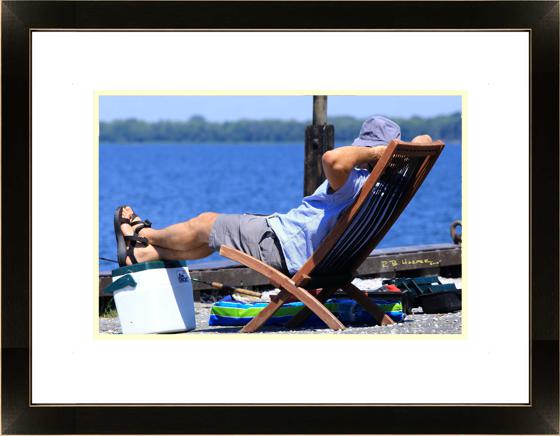
Category Archives: Photography
Wordless Wednesday
Road Trip XVI-12
In our prior episode, I drove into Texas to Jim Hall’s Chaparral cars, learned about drilling the Pembrian Basin, and got my shower outside instead of in as I drove across the state.
My coolers were nice and cold and ice filled, the freezer was at -2, and the batteries were full of juice. On the other hand, a slow moving weather system had me pinched. I crossed Texas in one jump because a large area of showers continued to move to the northeast around 15 mph right through the heart of the four state area. Much of the I-49 and I-20 corridors were soaking wet from Texarkana to Shreveport to Alexandria. The back edge of this area of rainfall extended from Longview to Lufkin and continued moving eastward with from Shreveport to Monroe and heading to Gulfport and Biloxi about the time I could get there.
In a trip full of superlatives, the Shreveport motel I found may have been the dirtiest room I have ever stayed in but at least the shower worked. And I plugged in the truck.
Someone outside a nearby room spent a while racer taping something together. I didn’t look on the off chance it was a body in a rug.
Since the room had neither micro frig nor microwave, I went looking for supper. It’s Louisiane, so I wanted something locally good and a po boy sounded just right. Big Os Catfish and More had a noisy bar and sticky floors but the young waitress was lovely and attentive and very nice although she had no idea what an ale was. I got a shrimp po boy fully dressed with fries and a Bud. It was fine. Just fine.
I went touring. I chose the J Bennett Johnston Waterway Center on Clyde Fant Pkwy. I wanted to see the Barksdale Global Power museum but I wasn’t sure they’d let me in Barksdale AFB without making me show them everything in the truck. There’s an interesting gallery in town, too.
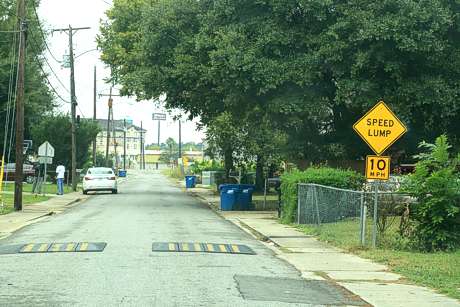
The weather, the Garmin, and the fact that Louisianne closes on Mondays made it less than a perfect day. I had some photo ops that I didn’t bother with because I didn’t want to get wet. Lila Too kept taking me to places she shouldn’t.
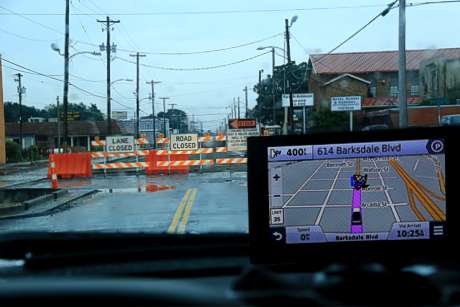
The art gallery was on Unobtanium Street and probably closed. The waterworks and railroad museum closes on Monday. I was there Monday.

In good news, I did get a private tour of the J Bennett Johnston Waterway Center.
The Army Corps of Engineers has rebuilt the Red River from NM to the Mississippi. This Shreveport section is a consistent 9-foot deep by 200-foot wide navigation channel from the confluence of Old and Red Rivers upstream for 236 miles to the Shreveport-Bossier City area. They built five navigation locks to create a lift of 141 feet for the standard 6-barge tow and towboat in a single lockage. They have also realigned the banks of the Red River by dredging and cutoffs, and by stabilizing its banks with revetments and dikes.
The Waterway Visitor Center was, of course, closed but an Army Corps engineer gave me a tour. of the Red River exhibits from past to present. The Corps of Engineers tamed the mighty Red for navigation and recreation through New Mexico, Texas, Oklahoma, Arkansas, and Louisiana. Their continuing mission is bank stabilization, dikes, dragging, and revetments on the river. The Port of Shreveport-Bossier handles over 2 million tons of goods each year.
A truck can deliver a ton of goods 59 miles on a gallon of fuel. A railroad takes that ton 202 miles on the same gallon. And an inland barge can carry the truck trailer and the railroad car 514 miles per ton on a gallon of fuel.
The Red River itself hosts bass tournaments plus recreational fishing and boating and has parks and campgrounds along its length.
Most interesting to me, after the history, were the mat sinking operations for revetment construction.
“The Red River used to wander around its valley like an unsupervised child, drifting this way and doubling back that way, looping and meandering and sometimes raising hell. The old New Orleans Crescent described it as a kind of perpetual motion machine, ‘a very whimsical and uncertain river,’ with sandbars appearing out of nowhere and banks eroding overnight…” Michael Grunwald wrote in the Washington Post in 2000.

The revetments are concrete blankets they lay from the shore out a few hundred feet at the bends to keep the bottom from shifting. It’s pretty cool terra forming.
Mat sinking is the core of the Corps of Engineers’ river stabilization program. Their Mat Sinking Unit is the only one of its kind in the world — its vessels build and distribute articulated concrete mat squares on the banks of the river. The mats prevent erosion and protect submerged river banks.

The Acadian Cultural Center is closed on Monday, too. I drove on to New Iberia where I saw boys skateboarding under the “no skateboarding” sign at the Clara Roy Pavilion in the Steamboat warehouse and got panhandled. The boys wanted to know if I was a photographer so we talked about that.

The pavilion entrance has a mural of the history French-speaking Acadians who established communities throughout the bayou country.
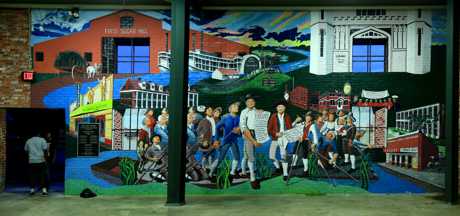
Writer James Lee Burke’s character, detective Dave Robicheaux, lives in New Iberia, perhaps because Mr. Burke spent his summers playing and fishing in his family’s hometown. His grandfather once lived right on Main Street in the city which has “southern manners and at the same time is a first-name kind of place.” Robicheaux lives out on Bayou Teche and prowls south Louisiana to fight crime in the books.
Unfortunately, New Iberia rolls up its streets early on Monday, so I didn’t see what I wanted to see. And Lila took me to West Main Street instead of East Main Street. It was fortuitous because I saw stores and people I wasn’t looking for, but still…
“East Main in New Iberia is probably one of the most beautiful streets in the Old South or perhaps the whole country.”
— A Stained White Radiance
Century-old oaks surround stately homes in the National Register Residential District. New Iberia’s Historic commercial district won the 2005 Great American Main Street Award, sponsored by the National Trust for Historic Preservation.
“My office was now located in City Hall, on Bayou Teche, with a grand view of a religious grotto and wonderful oak trees next to the city library.”
— The Glass Rainbow
Mr. Burke adopted New Iberia and the city returned the favor with stores and restaurants right from Dave Robicheaux’ adventures. The public park has a shrine dedicated to the Veterans of Foreign Wars from New Iberia who died in the service of the United States and the main branch of the Iberia Parish Library system houses the Bunk Johnson Jazz Collection Room.
I’ll go back to see the Bayou Teche in sunshine.
Next up, stops along the Gulf Coast in the rain and home.
Road Trip XVI-11
In our prior episode, I drove out of Arizona and through New Mexico where I still didn’t find my drivers’ license.
Texas!

Texas has the most farms and the highest acreage in the United States. The state is ranked #1 for revenue generated from total livestock and livestock products and #2 for total agricultural revenue. Beef cattle represent the largest single segment of Texas agriculture bringing $7.4 billion or 56.7% of the state’s annual agricultural cash receipts. Texas leads the nation in the production of cattle, horses, sheep, goats, wool, mohair, hay and cotton. Cotton earns $1.9 billion and dairy products make “only” $947 million.
Ever since the discovery of oil at Spindletop, Texas has grown to be the sixth largest oil producer in the world. The state has known petroleum deposits of about 5 billion barrels, which makes up about one-fourth of the known U.S. reserves. The state’s refineries can process 4.6 million barrels of oil a day. Texas also leads in natural gas production, producing one-fourth of the nation’s supply. Petroleum companies based in include Anadarko Petroleum Corporation, Conoco-Phillips, Exxon-Mobil, Halliburton, Marathon Oil, Tesoro, Valero, and Western Refining.
Despite the extraordinary mileage many Texans drive, they consume, on average, only the fifth most energy (of all types) in the nation per capita and as a whole, following behind Wyoming, Alaska, Louisiana, North Dakota, and Iowa.
I chatted with a gentleman in Amarillo who had driven across the state. He had a trailer-load furniture coming from his home in Houston to his “summer house” near Amarillo.
“I’ve already driven halfway to California,” he said. That was a Texas exaggeration but only by about 100 miles. Since I opted against El Paso and San Antonio for this trip, I’ll drive only 700 miles across Texas instead of 1,000.
My first view of the Lone Star State was a cotton field with oil derricks and there were almost uncountable horsehead pumps/nodding donkeys filling the fields the rest of the way in. The drive to Midland was mostly pretty desolate so I was surprised to see an orchard as I left one small town.
I made it to Midland in time to spend a couple of hours at the Permian Basin Petroleum Museum. Natch, I started at the Chaparral wing where I “test drove” the 2E and had my picture taken and drooled over all the other cars. Every one except the model I sat in is in running shape and kept that way purposefully.
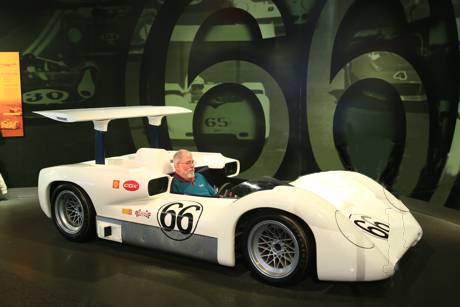
Mr. Hall was a founder and charter member of the West Texas Region of the SCCA in the 1950s. He raced the cars he built in Midland and competed in Formula One from 1960 to 1963 but his place in motor sports history came because he was the engineer and driver and part owner, with Hap Sharp, of Chaparral Cars.
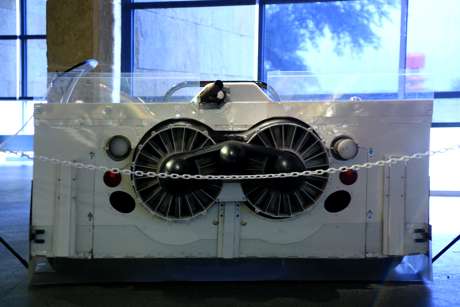
Chaparral built the most innovative racecars in the United States Road Racing Championship and in the Can-Am of the ’60s most obviously because his aerodynamics shaped the coming generations of racing. He drove in SCCA Trans-Am Series and won the 12-Hour at Sebring in the ’70s, then took over as a team owner in CART and Champ Car Racing.

His cars won the Indianapolis 500 with Al Unser driving in 1978 and Johnny Rutherford in 1980 in the radical new Chaparral 2K, the first ground effect car to be raced at Indy.
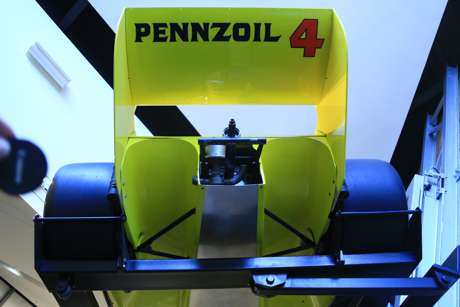 After reading Zuckerman’s The Frackers: The Outrageous Inside Story of the New Billionaire Wildcatters, the museum’s “this is how it works” exhibits showed me the actual iron used from the earliest oil fields on. Many of the exhibits were created to teach kids how great oil and oil exploration is. Mythcrackers is one, with an introductory film that dispelling common petroleum myths in a Family Feud-style game show because “it’s what you think you know that just ain’t so.” They have a large display of paintings by artist Tom Lovell.
After reading Zuckerman’s The Frackers: The Outrageous Inside Story of the New Billionaire Wildcatters, the museum’s “this is how it works” exhibits showed me the actual iron used from the earliest oil fields on. Many of the exhibits were created to teach kids how great oil and oil exploration is. Mythcrackers is one, with an introductory film that dispelling common petroleum myths in a Family Feud-style game show because “it’s what you think you know that just ain’t so.” They have a large display of paintings by artist Tom Lovell.
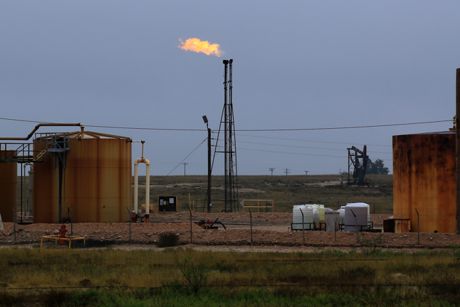 The industry museum shares the energy story and its impact on our daily lives with a journey through millions of years of history starting with the vast sea that covered the Permian Basin 230 million years ago.
The industry museum shares the energy story and its impact on our daily lives with a journey through millions of years of history starting with the vast sea that covered the Permian Basin 230 million years ago.
Lightning chased me from the outdoor drilling and pump exhibits, though.
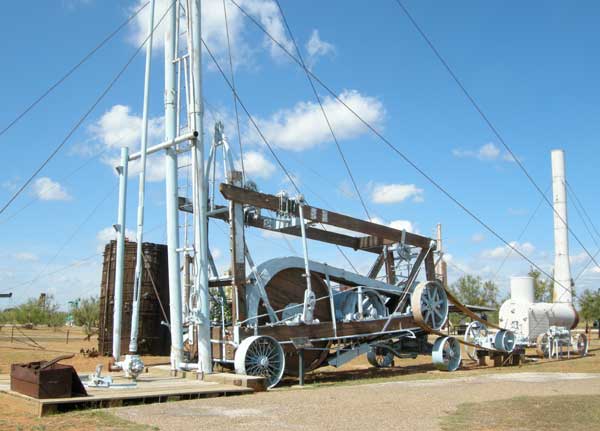 I had reserved a room in America’s Best Value Inn because when I called ahead to make sure I could check in with my passport, the desk clerk reminded me to book online because it was cheaper. I was quite pleased to have the real frig which froze my ices solid in the room. I left just three in the coolers overnight to keep them reasonable, so I had only a little ice to get. On the other hand, I could.not.make.the.shower.work. The tub had no obvious diverter on the spout and no valve. I went to the front desk.
I had reserved a room in America’s Best Value Inn because when I called ahead to make sure I could check in with my passport, the desk clerk reminded me to book online because it was cheaper. I was quite pleased to have the real frig which froze my ices solid in the room. I left just three in the coolers overnight to keep them reasonable, so I had only a little ice to get. On the other hand, I could.not.make.the.shower.work. The tub had no obvious diverter on the spout and no valve. I went to the front desk.
“This would have been a better night if you had a shower that worked or even a plug for the tub.”
“Oh, I’m sorry. You just have to pull on the thingie,” the desk clerk said.
Uh huh.
We eventually figured out that she meant to pull down on the aerator on the spigot. Like that’s intuitive.
It was going to rain so I had a waffle and headed for Shreveport.
Crossing the rest of Texas was a mostly boring, wet, ride. The rain started in earnest shortly after I left Midland, hammering down so hard some of the time that I used the fastest wiper speed and slowest truck speed, and continued until I was 50 miles from Louisiana. Traffic flowed at about 50 mph several times.
The highest speed limit I saw was just 75 and I don’t think anyone drove by at faster than 80 or 85. The rain meant I didn’t see all that much and wasn’t particularly enticed by any side trips. The rain also meant the NASCAR Cup race in Fort Worth turned into a night race, finally getting underway after a rain delay of nearly six hours Sunday. Reed Sorenson drove the #55 Trump-Pence Toyota which may have clinched the election although he finished the race in 35th.
Speaking of speed, Dale Earnhardt Jr. is still driving fast, even though he has been sidelined from NASCAR because of a concussion. Junior was pulled over for speeding while driving to Texas Motor Speedway on Sunday morning. His fiancee who was in the car with him tweeted a picture of a police officer writing out a warning for NASCAR’s most popular driver. According to her tweet, Junior didn’t get ticketed. She didn’t say how fast he was going.
 I passed the huge Sweetwater wind farm in Nolan County but just one turbine out of 346 was turning. Sweetwater was built in five phases with GE 1.5 megawatt S turbines, SLE turbines, and XLE turbines plus Mitsubishi 1.0 megawatt turbines and Siemens 2.3 megawatt turbines.
I passed the huge Sweetwater wind farm in Nolan County but just one turbine out of 346 was turning. Sweetwater was built in five phases with GE 1.5 megawatt S turbines, SLE turbines, and XLE turbines plus Mitsubishi 1.0 megawatt turbines and Siemens 2.3 megawatt turbines.
I also passed an LA Fitness right next to a Golden Buffet.
Gas was consistently above $2/gallon across the state and seemed to average between $2.09 and $2.19. I filled the tank with Sunoco in Midland for $1.999.
Next stop the J Bennett Johnston Waterway, Dave Robicheaux’s house on the Teche, and a po’ boy.
Road Trip XVI-10
In our prior episode, I took some days off in Paradise Valley, then fired up the (new)(white) truck for the trip back up to 6,500 feet elevation.
It takes a lot longer to head over the mountain than I remembered. I went around the Mogollon Rim (elev 7,500) in northeastern Arizona on the way.

It’s 331 miles and should take 5 hours 25 minutes but I stopped to pee and to take a picture or two and then lost an hour to the time zone difference.
And, of course, it was good to get back on the Mother Road. Remember to slow down for the Notel Motel.
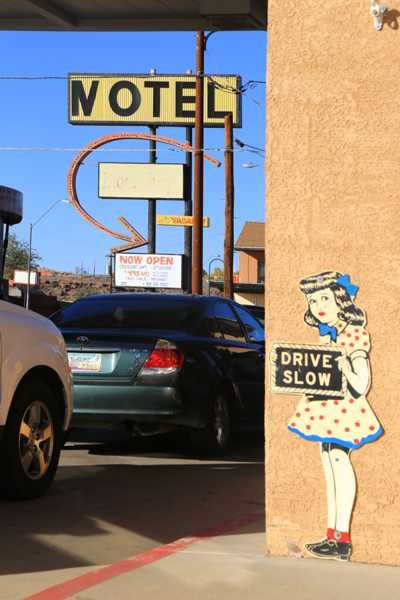
The truck ate up the elevation change again and I avoided staying in the Notel. Still, I took a couple more days off to visit once I got back in New Mexico, of course.
The radar showed serious, heavy rain over Texas from Amarillo down to the Alamo and east all the way to Louisiana, all following a Front that had bowed and stopped from Roswell to southeastern KS where it turned and headed for Buffalo. The slow moving low pressure system riding that Front will brought increasing chances for rain over much of NM and TX for my entire tour there.
I reloaded the truck in the rain in Grants but I figured out a way to prop the bumbershoot up over the back window of the cap. Unfortunately, I thought of that after I had filled the coolers with rainwater. I got everything in and battened down and left about on schedule. It rained hard enough along I40 that I slowed down to 55 in a couple of spots when I started hydroplaning just a little.
The Albuquerque motel that was holding my driver’s license hostage wasn’t where their address says it was but I found it by asking at all the other motels along the strip. Finally recognized it. They hadn’t “refound” my license so I continued on my way on to Roswell to find the little green men. I had high hopes they would accept my latest colonoscopy results.
I drove through the mysterious, desolate village of Encino, pop 94, the city of dusty oaks on US 60 where I took some photos of Encino Motel Management. I’m thinking Encino doesn’t need a whole lot of motel management.
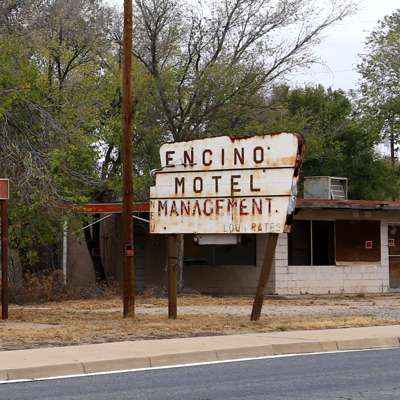
The highway going into Roswell has a lot of irrigation running and a number of green fields that stand out from the surrounding scrub.
I read here in Roswell that they’re going to launch some weasels up in a rocket.
“So where are they headed?” I asked.
Otter space, of course!
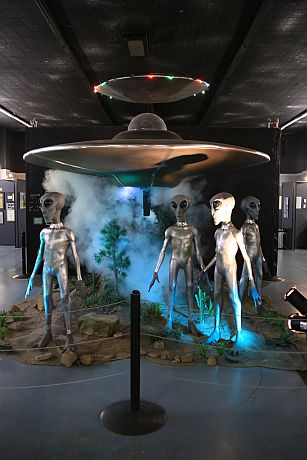
In 1947, something happened during a severe thunderstorm northwest of Roswell, New Mexico. Was it a flying saucer? Was it a weather balloon? What happened? The Roswell UFO Museum has a lot of documentation and a lot of detail but I couldn’t get past the humanoid appearance. It’s just too easy and too science fictiony. The 1990 sighting in Doylestown, PA, did catch my eye, though. And my colonoscopy results did get me a reduced admission price.

The Budget Motel had my reservation and was ready for me. The desk clerk told me I could plug my truck into my room, but the door seal was too tight for the cord. She gave me another parking space right next to the office and let me plug in there. And if I had had a mini-port-to-HDMI cable, I could have used their 32″ wall mounted Samsung for a computer monitor. The room a/c-heater fan was too loud, though.
The motel backed onto the Emergency Room landing pad for the local hospital. Two deliveries came in while I was jockeying the truck around.
I went to the Roswell Museum and Art Center the next morning. It’s home to the largest public collection of works by Peter Hurd and Henriette Wyeth, painters whom I knew of but had never met. I found both have become synonymous with the landscape and culture of southeastern New Mexico. Hurd was raised in Roswell where his father worked a small ranch southwest of town. His father hoped he would pursue a military career, but after NMMI and two years at West Point, Hurd dropped out of West Point to study with N. C. Wyeth in Chadds Ford in the 1920s. During the summers at Wyeth’s home, Hurd met Henriette, Andy’s sister and the eldest of the Wyeth kids. They were married in 1929 and moved permanently to their Sentinel Ranch in San Patricio, New Mexico a few years later.
I had thought of him as one of the multitude of Brandywine artists and never twigged that he might be from somewhere else. I really enjoyed that collection.
The New Mexico Military Institute is the only state-supported military high school and two-year college in the western United States. NMMI also has a “notable” collection of art and historical objects in the Roswell Museum. Their Duty, Honor, Art was a mix of portraits of officers and more traditional landscapes. Art of the Book was fascinating as was Artists by Artists (portraits of artists by others) but I didn’t think much of the Bravo/Grande project. That “interdisciplinary project that examines the relationship between regional communities and the river” but it was all pretty two-faced to me.
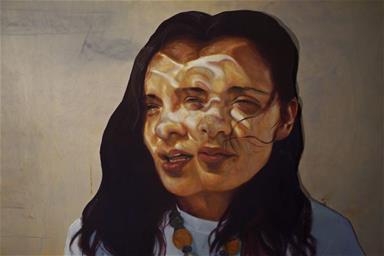
I didn’t visit the Goddard Planetarium because their shows are on Wednesdays and one Saturday each month and, unfortunately, I missed the Robert H. Goddard Collection of scientific equipment and rocket parts.
Next stop Midland, TX, for race cars and oil wells with maybe the rain coming right along with me.

